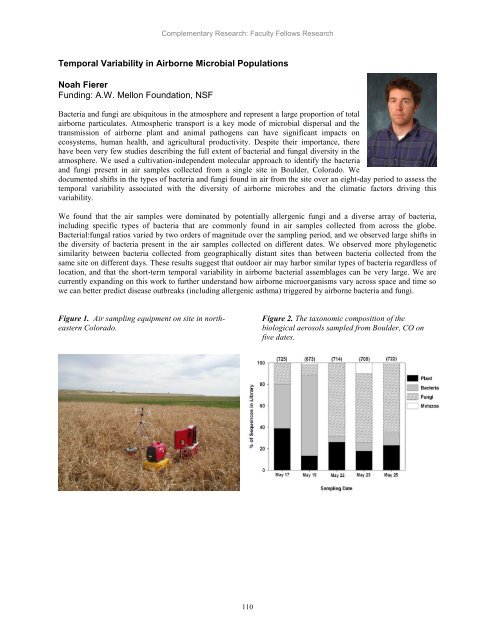Scientific Theme: Advanced Modeling and Observing Systems
Scientific Theme: Advanced Modeling and Observing Systems
Scientific Theme: Advanced Modeling and Observing Systems
Create successful ePaper yourself
Turn your PDF publications into a flip-book with our unique Google optimized e-Paper software.
Complementary Research: Faculty Fellows Research<br />
Temporal Variability in Airborne Microbial Populations<br />
Noah Fierer<br />
Funding: A.W. Mellon Foundation, NSF<br />
Bacteria <strong>and</strong> fungi are ubiquitous in the atmosphere <strong>and</strong> represent a large proportion of total<br />
airborne particulates. Atmospheric transport is a key mode of microbial dispersal <strong>and</strong> the<br />
transmission of airborne plant <strong>and</strong> animal pathogens can have significant impacts on<br />
ecosystems, human health, <strong>and</strong> agricultural productivity. Despite their importance, there<br />
have been very few studies describing the full extent of bacterial <strong>and</strong> fungal diversity in the<br />
atmosphere. We used a cultivation-independent molecular approach to identify the bacteria<br />
<strong>and</strong> fungi present in air samples collected from a single site in Boulder, Colorado. We<br />
documented shifts in the types of bacteria <strong>and</strong> fungi found in air from the site over an eight-day period to assess the<br />
temporal variability associated with the diversity of airborne microbes <strong>and</strong> the climatic factors driving this<br />
variability.<br />
We found that the air samples were dominated by potentially allergenic fungi <strong>and</strong> a diverse array of bacteria,<br />
including specific types of bacteria that are commonly found in air samples collected from across the globe.<br />
Bacterial:fungal ratios varied by two orders of magnitude over the sampling period, <strong>and</strong> we observed large shifts in<br />
the diversity of bacteria present in the air samples collected on different dates. We observed more phylogenetic<br />
similarity between bacteria collected from geographically distant sites than between bacteria collected from the<br />
same site on different days. These results suggest that outdoor air may harbor similar types of bacteria regardless of<br />
location, <strong>and</strong> that the short-term temporal variability in airborne bacterial assemblages can be very large. We are<br />
currently exp<strong>and</strong>ing on this work to further underst<strong>and</strong> how airborne microorganisms vary across space <strong>and</strong> time so<br />
we can better predict disease outbreaks (including allergenic asthma) triggered by airborne bacteria <strong>and</strong> fungi.<br />
Figure 1. Air sampling equipment on site in northeastern<br />
Colorado.<br />
110<br />
Figure 2. The taxonomic composition of the<br />
biological aerosols sampled from Boulder, CO on<br />
five dates.
















